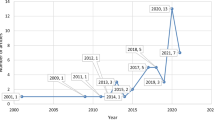Abstract
A bibliometric analysis was performed on a set of 1718 documents relating to Web 2.0 to explore the dimensions and characteristics of this emerging field. It has been found that Web 2.0 has its root deep in social networks with medicine and sociology as the major contributing disciplines to the scholarly publications beyond its technology backbone — information and computer science. Terms germane to Web 2.0, extracted from the data collected in this study, were also visualized to reflect the very nature of this rising star on the Internet. Web 2.0, according to the current research, is of the user, by the user, and more importantly, for the user.
Similar content being viewed by others
References
Allen, R. S. (2001), Interdisciplinary research: A literature-based examination of disciplinary intersections using a common tool, Geographic Information System (GIS). Science & Technology Libraries, 21: 191–209.
Borgman, C., Furner, J. (2002), Scholarly communication and bibliometrics. Annual Review of Information Science & Technology, 36: 3–72.
Boutin, P., Web 2.0: The new Internet “boom” does not live up to its name. http://www.slate.com/id/2138951. March 29, 2006.
Bradford, S. C., Documentation, Crosby Lockwood, London, 1948.
Calero, C., Buter, R., Valoes, C., Noyons, E. (2006), How to identify research groups using publication analysis: An example in the field of nanotechnology, Scientometrics, 66: 365–376.
Fennewald, J. (2007), The ACRL conferences: A profile of its presenters, College & Research Libraries, 68: 107–18.
Gutmans, A., What is Web 2.0? [Video]. http://www.youtube.com/watch?v=0LzQIUAN nHc. September 10, 2006.
Hassan, E. (2003), Simultaneous mapping of interactions between scientific and technological knowledge bases: The case of space communications, Journal of the American Society for Information Science and Technology, 54: 462–468.
Kipp, M. E. I., Campbell, D. G., Patterns and inconsistencies in collaborative tagging systems: An examination of tagging practices. Proceedings of the 69 th Annual Meeting of the American Society for Information Science and Technology, [CD-ROM]. Also available: http://eprints.rclis.org/archive/00008315, 2006.
Madden, M., Fox, S., Riding the waves of “Web 2.0”: More than a buzzword, but still not easily defined, Pew Internet & American Life Project. http://www.pewinternet.org/PPF/r/189/report_display.asp. October 5, 2006.
O’Reilly, T., What is Web 2.0? http://www.oreillynet.com/pub/a/oreilly/tim/news/2005/09/30/what-is-web-20.html. September 30, 2005.
Reid, E. O. F. (1997), Evolution of a body of knowledge: An analysis of terrorism research. Information Processing & Management, 33: 91–106.
White, H.D., Mccain, K.W. (1997), Visualization of literatures, Annual Review of Information Science & Technology, 32: 99–168.
Zhao, D., Logan, E. (2001), Citation analysis of scientific publications on the Web: A case study on the research area of XML, Proceedings of the 8th International Conference on Scientometrics and Informatics, 2: 779–794.
Author information
Authors and Affiliations
Corresponding author
Rights and permissions
About this article
Cite this article
Chu, H., Xu, C. Web 2.0 and its dimensions in the scholarly world. Scientometrics 80, 717–729 (2009). https://doi.org/10.1007/s11192-008-2103-y
Received:
Published:
Issue Date:
DOI: https://doi.org/10.1007/s11192-008-2103-y




